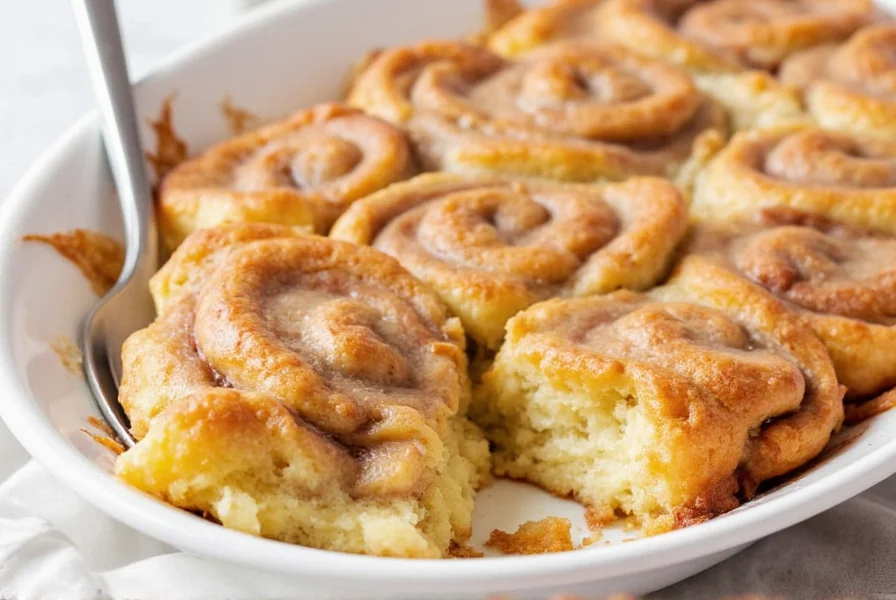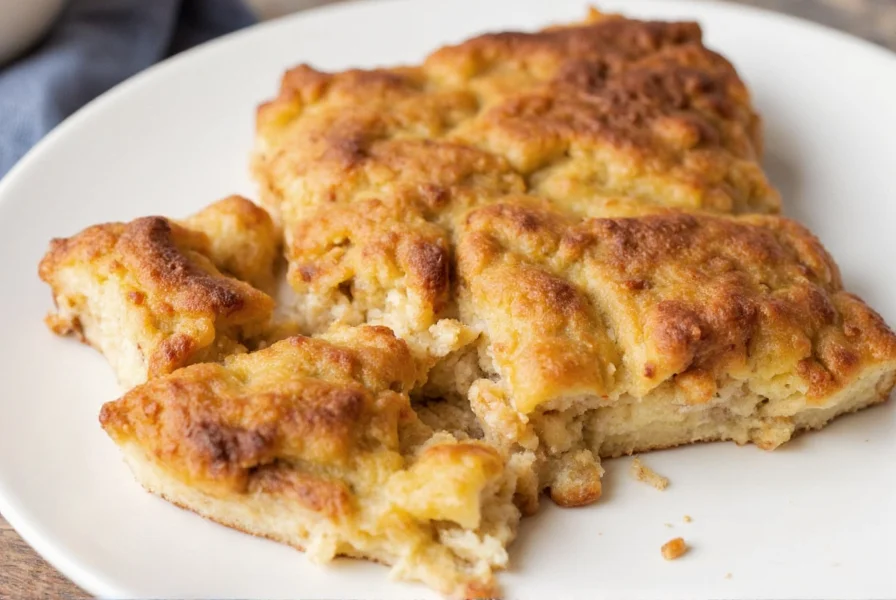Looking for a show-stopping breakfast that's both easy to prepare and impressive to serve? The cinnamon roll breakfast casserole delivers the beloved flavors of classic cinnamon rolls in a convenient, crowd-pleasing format. Unlike traditional cinnamon rolls that require individual preparation, this casserole bakes in a single dish, making it ideal for feeding a group with minimal morning effort. The magic happens when layers of bread, cinnamon filling, and egg custard meld together during baking, creating a texture that's simultaneously fluffy and dense, with pockets of melted cinnamon sugar throughout.
What sets the best cinnamon roll breakfast casseroole apart is the balance between the rich custard base and the sweet cinnamon topping. When prepared correctly, the bottom layer becomes a tender bread pudding consistency while the top develops a delightful crunch from the cinnamon-sugar mixture. This make-ahead breakfast casserole can be assembled the night before, refrigerated, then baked fresh in the morning—perfect for stress-free holiday entertaining or lazy weekend brunches.
Essential Ingredients for Perfect Results
| Ingredient | Quantity | Key Purpose |
|---|---|---|
| Cinnamon swirl bread or croissants | 16-20 oz | Provides the base structure and cinnamon flavor |
| Large eggs | 6 | Creates the custard base that binds ingredients |
| Whole milk or half-and-half | 1½ cups | Adds richness to the custard mixture |
| Granulated sugar | ⅓ cup | Sweetens the custard base |
| Vanilla extract | 2 tsp | Enhances overall flavor profile |
| Cinnamon | 2 tsp | Essential spice for authentic flavor |
| Cream cheese | 8 oz | Creates the signature sweet glaze topping |
| Powdered sugar | 1 cup | Sweetens the cream cheese glaze |
Step-by-Step Preparation Guide
Creating the perfect cinnamon roll breakfast casserole requires attention to layering and timing. Follow these professional techniques for optimal results:
- Prepare the bread base: Cut day-old cinnamon swirl bread or croissants into 1-inch cubes. Arrange half the cubes in a greased 9x13-inch baking dish, ensuring even coverage without large gaps.
- Create the cinnamon layer: Mix ½ cup brown sugar with 2 tablespoons cinnamon. Sprinkle half this mixture evenly over the bread cubes, pressing gently to adhere.
- Add second bread layer: Place remaining bread cubes over the cinnamon layer, then sprinkle with the rest of the cinnamon-sugar mixture.
- Prepare custard mixture: Whisk 6 eggs with 1½ cups milk, ⅓ cup sugar, 2 teaspoons vanilla, and ½ teaspoon salt until completely smooth—no streaks of egg white should remain.
- Soak the casserole: Slowly pour custard over bread layers. Press down gently with a spatula to ensure all bread is saturated. Cover and refrigerate for at least 4 hours (preferably overnight).
- Bake to perfection: Preheat oven to 350°F. Bake uncovered for 45-55 minutes until center is set and top is golden brown. A knife inserted should come out clean.
- Make cream cheese glaze: While casserole bakes, beat 8 oz softened cream cheese with 1 cup powdered sugar, 2 tablespoons milk, and 1 teaspoon vanilla until smooth. Drizzle over warm casserole.
Pro Tips for Best Results
Professional chefs recommend these techniques to elevate your cinnamon roll breakfast casserole from good to exceptional:
- Bread selection matters: Use day-old bread for better custard absorption. Cinnamon swirl bread provides authentic flavor, but you can substitute with plain croissants and add extra cinnamon-sugar layers.
- Temperature control: Remove the casserole from the refrigerator 20 minutes before baking. Cold dishes going straight into the oven often result in uneven cooking.
- Custard consistency: For a richer texture, replace ½ cup milk with heavy cream. The higher fat content creates a more luxurious mouthfeel without making the casserole greasy.
- Prevent soggy bottoms: If using very moist bread like brioche, toast the cubes at 300°F for 10 minutes before assembling to remove excess moisture.
- Glaze application: Wait until the casserole has cooled for 10 minutes before adding the cream cheese glaze. Applying it too soon causes the glaze to melt into the casserole rather than creating that signature drizzle effect.

Variations to Suit Any Occasion
Customize your cinnamon roll breakfast casserole for different dietary needs and preferences while maintaining that signature flavor:
- Gluten-free version: Use gluten-free cinnamon rolls or bread. Many specialty bakeries now offer gluten-free options that work well in this recipe. Add 1 teaspoon xanthan gum to the custard mixture to improve binding.
- Dairy-free adaptation: Substitute coconut milk for dairy milk and use vegan cream cheese for the glaze. The natural sweetness of coconut complements the cinnamon flavors beautifully.
- Protein boost: Add ½ cup chopped pecans or walnuts between layers for added texture and protein. For even more protein, whisk 2 tablespoons protein powder into the custard mixture.
- Festive holiday twist: Add ¼ cup dried cranberries and 2 teaspoons orange zest to the custard mixture for a holiday-inspired variation that pairs perfectly with Thanksgiving or Christmas brunch.
- Savory-sweet balance: For those who prefer less sweetness, reduce the custard sugar to ¼ cup and the glaze powdered sugar to ¾ cup. Add a pinch of sea salt to each layer to enhance flavor complexity.
Storage and Reheating Instructions
Proper storage ensures your cinnamon roll breakfast casserole maintains quality for days:
- Refrigeration: Store leftovers in an airtight container for up to 4 days. The custard base keeps exceptionally well when refrigerated.
- Freezing: Wrap individual portions tightly in plastic wrap, then aluminum foil. Freeze for up to 2 months. Thaw overnight in the refrigerator before reheating.
- Reheating methods:
- Microwave: 60-90 seconds on medium power for single portions
- Oven: 300°F for 15-20 minutes, covered with foil, for whole dish
- Toaster oven: 10-12 minutes at 325°F for individual slices
- Reviving texture: Sprinkle a few drops of milk over the casserole before reheating to restore moisture. Add a small pat of butter on top during the last 5 minutes of oven reheating for extra richness.
Common Mistakes to Avoid
Even experienced cooks can encounter issues with cinnamon roll breakfast casserole. Here's how to prevent the most frequent problems:
- Soggy texture: Using fresh bread instead of slightly stale bread causes excess moisture. Always use bread that's at least one day old, or toast fresh bread cubes before assembling.
- Undercooked center: Cutting into the casserole too soon makes the center appear runny. Allow it to rest for 15-20 minutes after baking—the custard continues to set during this time.
- Glaze that won't set: Using warm cream cheese creates a runny glaze. Always use softened (not warm) cream cheese and chill the glaze for 10 minutes before drizzling.
- Burnt edges: Baking at too high a temperature causes edges to burn before the center sets. Never exceed 350°F, and consider using an oven thermometer to verify accuracy.
- Flavor imbalance: Overloading with cinnamon creates bitterness. Stick to the recommended 2 teaspoons in the custard and 2 tablespoons in the sugar mixture for balanced flavor.

Frequently Asked Questions
Can I prepare cinnamon roll breakfast casserole the night before?
Yes, the casserole is designed as a make-ahead breakfast dish. Assemble the entire casserole, cover tightly, and refrigerate for 8-12 hours before baking. The bread needs this time to properly absorb the custard mixture. When ready to bake, remove from refrigerator 20 minutes before placing in the oven to ensure even cooking.
What's the difference between using crescent rolls versus cinnamon bread for this casserole?
Crescent rolls create a flakier, more pastry-like texture with distinct layers, while cinnamon bread provides a more traditional bread pudding consistency. Crescent rolls require additional cinnamon-sugar sprinkling between layers since they lack the swirl pattern. For best results with crescent rolls, separate the triangles, sprinkle with cinnamon sugar, then cut into 1-inch strips before layering.
How do I know when the cinnamon roll breakfast casserole is fully baked?
The casserole is done when the center is set and no longer jiggles, the top is golden brown, and a knife inserted in the center comes out clean. Internal temperature should reach 160°F. Allow 5-10 minutes of resting time after baking—the custard continues to set during this period. Overbaking causes dryness, while underbaking leaves a runny center.
Can I make this casserole without cream cheese in the glaze?
Yes, you can create a simple powdered sugar glaze using 1 cup powdered sugar, 2-3 tablespoons milk, and 1 teaspoon vanilla extract. For added flavor, incorporate ½ teaspoon cinnamon. While cream cheese adds richness and tang that complements the sweet bread, this alternative still provides the signature drizzle without dairy. Maple syrup or honey can also substitute for part of the powdered sugar for different flavor notes.
What are the best occasions to serve cinnamon roll breakfast casserole?
This versatile dish shines at holiday brunches (Easter, Christmas, Thanksgiving), baby or bridal showers, and weekend family gatherings. Its make-ahead nature makes it ideal for events where you want to minimize morning preparation. For casual settings, serve with fresh fruit; for special occasions, pair with champagne or mimosas. The casserole also works well as a portable dish for potlucks since it holds its structure when sliced.











 浙公网安备
33010002000092号
浙公网安备
33010002000092号 浙B2-20120091-4
浙B2-20120091-4